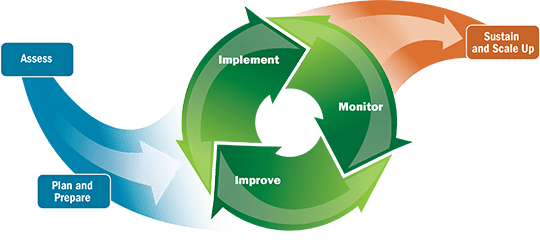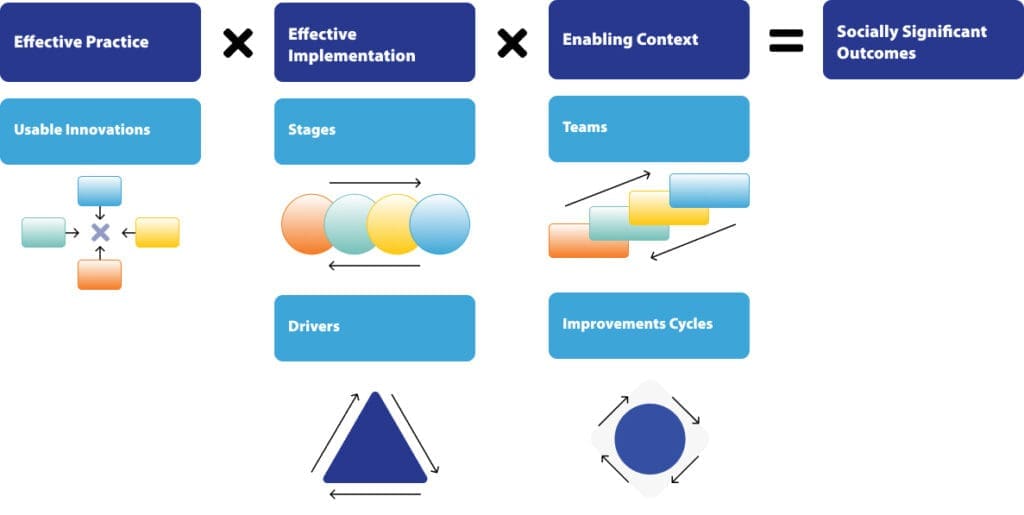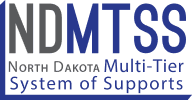Effective Implementation
Active Implementation Formula
“Students will not benefit from programs and practices that they do not experience or that are not implemented with a high degree of fidelity. It is not enough to identify effective interventions (the “WHAT”) but we also need to consider implementation practices and conditions necessary (the “HOW”) to ensure positive outcomes for students.”
Understanding the essential components of NDMTSS is an important part of its implementation, but research suggests effective implementation is a major challenge for educators. Successful implementation of MTSS demands ongoing planning, continuous improvement, and sustaining and expanding efforts. Teams must examine current capacity and readiness, develop plans for ongoing professional learning, create structures and processes, conduct ongoing evaluation and review of implementation to inform continuous improvement, and engage stakeholders as partners in the work.

*Adapted from SISEP
Effective Implementation
Implementation science and the Active Implementation Formula recognizes the need for effective practices that are implemented well and supported by teams and processes for improvement. All three are necessary to produce significant outcomes for students. The NDMTSS trainings for academics and behavior have been developed into a multi-year training plan to support school teams through the phases of implementation. Below are descriptions of the Phases of Implementation and the NDMTSS Training Roadmap reflecting trainings available to support implementation at each phase.
Phases of Implementation
*Adapted from NDMTSS from the Center on Multi-Tiered Systems of Support by the American Institutes of Research, 2022.
-
Phase 1: Plan for Success
During the planning phase, teams focus on building the infrastructure necessary to support MTSS implementation. Activities at this phase may include conducting needs assessments, identifying priorities, establishing a vision for MTSS, inventorying resources, developing implementation and evaluation plans, and selecting valid assessments and evidence-based intervention. Professional learning focuses on building staff buy-in and staff capacity to implement the NDMTSS essential components. (Exploration & Installation) -
Phase 2: Implement
During initial implementation of MTSS, staff implement the processes, assessment and interventions identified and developed during Phase 1. Monitoring fidelity of implementation is critical at this phase and teams should identify and address barriers to implementation through regular teaming and problem solving. Ongoing professional learning focuses on improving staff’s use of data, increasing quality of instruction, and refining implementation fidelity of the NDMTSS essential components. It is important to remember that full implementation of the essential components is necessary to realize the full benefits of MTSS implementation. -
Phase 3: Sustain and Expand
Effective MTSS implementation requires teams to regularly engage in continuous improvement activities. The focus of these activities is to improve the efficacy and efficiency of MTSS implementation but also address the evolving needs of staff, students, and state and federal demands. MTSS teams continue to build infrastructure and align existing systems to ensure staff can sustain full MTSS implementation, even when faced with staff turnover and changing priorities. It is important that teams focus on sustaining and expanding MTSS implementation through ongoing data analyses and stakeholder engagement.
Active Implementation Framework
Active Implementation promotes the full and effective use of evidence-based programs and practices so that student outcomes are improved.
Active Implementation is guided by five frameworks:
- Usable Innovations
- Implementations Stages
- Implementation Drivers
- Implementation Teams
- Improvement Cycles
Effective Practice
Implementation science and the Active Implementation Formula recognizes the need for effective practices that are implemented well and supported by teams and processes for improvement. All three are necessary to produce significant outcomes for students. The NDMTSS trainings for academics and behavior have been developed into a multi-year training plan to support school teams through the phases of implementation. Below are descriptions of the Phases of Implementation and the NDMTSS Training Roadmap reflecting trainings available to support implementation at each phase.
Usable Innovations
Innovations (i.e., evidence-based programs or practices) need to be teachable, learnable, doable, and readily assessed in practice.
Before implementing an evidence-based practice, it is vital to have a clear understanding of the program and its suitability for your agency or organization. It is necessary to have sufficient detail about the evidence-based practice so that you can train staff and administrators to use it competently; measure the use of the practice with fidelity or integrity; and replicate it across all of your implementing sites such as classrooms, schools, and districts (Fixsen, Blase, Metz, & Van Dyke, 2013; Metz, 2016). The following criteria need to be in place to ensure that your evidence-based practice is usable:
Usable Innovations
- Clear description of the program
- Clear essential functions that define the program
- Operational definitions of program components
- Practical Fidelity Assessment
Examples of Usable Innovations in NDMTSS:
- Evidence-Based Programs
- Evidence-Based Practices
- Promising Practices
- High Quality Instruction and Intervention Materials
- Grade Level Content Standards & Behavioral Expectations
- Effective Instruction & Intensification
Effective Implementation
Stages of Implementation
Stages of Implementation
Implementation is not an event. Implementation is “a specified set of activities designed to put into practice an activity or program” (Fixen, Naoom, Blase, Friedman, & Wallace, 2005, p. 6). These activities occur over time in stages that overlap and that are revisited as needed. There are four functional Implementation Stages: Exploration, Installation, Initial Implementation, and Full Implementation.
-
Exploration
Identifying the need for change, learning about possible interventions that may be solutions, creating readiness for change, learning about what it takes to implement the innovation effectively, developing stakeholders and champions, deciding to proceed (or not). -
Installation
Establishing the resources needed to use an innovation and resources required to implement the innovation with fidelity resulting in good outcomes for students. -
Initial Implementation
The first use of an innovation by educators and others working in a school and district environment that is just learning how to support the new ways of work (sometimes referred to as the “awkward stage”). -
Full Implementation
TThe skillful use of an innovation well-integrated into the repertoire of educators and routinely supported by roles, functions, and structures supported by building and district administrations.
Implementation Drivers
Implementation Drivers
Implementation Drivers facilitate and ensure the success of initiatives. They are based on common features that exist among many successfully implemented programs and practices. The structural components and activities that make up each Implementation Driver are the core components needed to initiate, support, and sustain classroom, building, and district-level change. It is imperative that each Driver is developed using the strengths of the community and attends to the necessary actions to advance equitable outcomes for all students and families.
- Competency Drivers are activities to develop, improve, and sustain educator and administrator ability to implement evidence-based programs, practices, and innovations as intended to benefit students. The four competency drivers include Selection, Training, Coaching, and Fidelity Assessment. Collectively they can effectively provide professional development that makes a difference for both practitioners and students.
- Organization Drivers are used to develop the supports and infrastructure needed to create a Hospitable Environment for new programs and practices. These supports may need to be developed across the building and district level. The three organizational drivers are Decision-Support Data Systems, Facilitative Administration, and Systems Interventions.
-
Leadership focuses on providing the right leadership strategies for different types of leadership challenges. These leadership challenges often emerge as part of the change management process needed to make decisions, provide guidance, and support organization functioning.
It is important to note that leadership is foundational to Implementation Drivers and implementation work in general. Leadership is needed at all levels of the system to not only keep work moving forward by managing change, but also support teams and practitioners in removing barriers to implementation.
When integrated and used collectively, these drivers ensure high-fidelity and sustainable program implementation.
Enabling Contexts
Enabling Contexts
- Implementation Teamss leverage implementation science principles, to support the widespread use of evidence-based programs and practices Effective implementation is characterized by a team accountable for “making it happen.” that also attends to equity at each step in the implementation process. Implementation Teams provide an internal support structure to move selected programs and practices through the Implementation Stages. They also ensure that the implementation infrastructure, as detailed in the Implementation Drivers discussed earlier, is effectively used to support the programs and practices.
-
Improvement Cycles are based on a Plan, Do, Study, Act process.
While there are many models for continuous improvement, Plan-Do-Study-Act (PDSA) Cycles provide Implementation Teams with a framework for problem-solving barriers. Many times, implementers, support staff, and teams experience similar, consistent barriers to implementing an evidence-based program or practice as intended. These barriers include lack of training, inadequate communication, low buy-in, and ineffective coaching, among others. Implementation Teams employ PDSA cycles to intentionally identify, problem-solve, and address these barriers and improve implementation.
The PDSA cycles consist of four phases:
- Plan – identify barriers or challenges, using multiple data points, and specify the plan to move programs or innovations forward and identify the outcomes that will be monitored,
- Do – carry out the strategies or plan as specified to address the challenges,
- Study – use the measures identified during the planning phase to assess and track progress,
- Act – make changes to the next iteration of the plan to improve implementation.
Summary
Conducting stage-appropriate implementation activities is necessary for successful service and systems change. Developing core implementation components results in an implementation infrastructure that supports competent and sustainable use of evidence-based programs or practices. Creating Implementation Teams that actively work to support the implementation of innovations results in more efficient, higher-quality implementation. Connecting policy to practice can help reduce systems’ barriers to sustainable, high-fidelity practice. Working together, these Active Implementation Frameworks provide the foundation for evidence-based programs and practices to be successfully implemented with fidelity.



